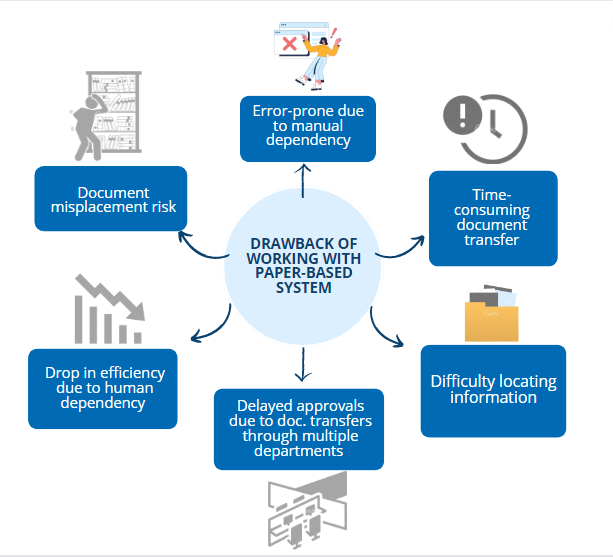Introduction
Every business strives to enhance its operations and improve its bottom line. With increased access to high-speed internet, finding information is no longer a major challenge. Instead, the main hurdle is to deliver efficiently and then some, with no room for any discrepancies or setbacks. This raises questions like:
- How can we make processes more efficient?
- How do we ensure updates and upgrades survive long-term?
- What if we need to make new changes?
Traditional systems, such as paper-based or manual file transfer methods, leave much room for human errors and process inefficiencies. The evident drawbacks include:

A recent report by Finances Online suggests that about 50% of an employee’s time is spent just creating documents. It further highlighted that 72% of companies still use a hybrid of paper-based and digital systems for working.
Why do enterprises not want to go paperless? What’s stopping organizations from embracing digitization? Personally, we at Symtrax feel that digital transformation is the future. But can being even partially digital improve business performance? If so, what are the business benefits of digitization, and how can it be implemented? Let’s take a closer look at these questions.
Drawbacks of using legacy systems
We generally view the term ‘legacy system’ as something currently in use that brings about positive, qualitative results. However, in the digital world, legacy systems are seen as overworked and time-worn. Furthermore, these systems could pose subtle challenges and hamper business activities with their limitations.
While going digital might seem expensive, relying too much on legacy systems could incur increasing costs over time. But what exactly are these costs? And how can they impact your business?
Costs involved with legacy systems
Legacy systems are often not easy to fully understand, maintain, or work with. The younger workforce tends to find working with these systems laborious, reducing overall productivity and efficiency. These systems incur direct and indirect costs, which some businesses tend not to consider while retaining the legacy systems.
Let’s examine a few of the costs of working with legacy systems:
Direct costs
Upgrading Cost
According to Gartner, every dollar invested in digitizing business would require companies to spend around three times that much to upgrade their legacy system. Legacy systems in general lack certain version enhancements or modules, leaving businesses with no other option but to upgrade. One thing leads to another, and businesses end up spending more tot upgrade those modules too.
This in turn often does not provide businesses with workaround options. What’s more, these upgrades could cause companies to spend amounts upwards of 6 digits. It is difficult to pinpoint a specific figure because the cost can range from a few thousand to a few hundred thousand dollars depending on the size of the system.
Maintenance Cost
According to a survey, 25% of IT budgets are estimated to go towards supporting and maintaining legacy systems. From our understanding, enterprises incur annual maintenance costs for these systems, which are pre-determined and agreed upon. While this might sound straightforward, it adds up to a great deal of money spent over time .
Indirect Costs
Time taken to maintain the system
Implementing upgrades or enhancements to legacy systems can prove to be an arduous task. The administrator and server team might spend countless man hours to identify and replicate the steps and actions for legacy system maintenance. As such, much of their time and effort would be inefficiently used. In today’s demanding times, where time is money, such a valuable team spending their time purely in an attempt to understand a system might be viewed as unacceptable.
Employee productivity
In today’s competitive world, employees can find it difficult to adjust to outdated legacy systems with less or only basic features.
A report by G2 confirms that 95% of employees confirmed that they would be satisfied with their work if they had better software to work with . Having fewer features, tools, and software not only reduces employee productivity but can reflect badly on a company and its future-proofing strategies. As such, employees are often faced with reduced efficiency due to less-than-optimal systems, impacting the customer’s experience.
Customer Satisfaction
Customer satisfaction directly depends on communication and timeliness. For service-based industries, such as banking, finance, and healthcare, system performance directly affects overall satisfaction and customer experience.
Delays in processing documents or handling requests or being unable to obtain approvals on short notice (among other issues) can harm vendor and partner relationships in any industry. Furthermore, business partners will often react negatively when they are faced with inefficient processes, a lack of innovation, or an inability to keep up with business trends.
Lack of B2B integration
The concept of partner ecosystems has been gaining popularity in the business world. A partner ecosystem refers to a seamless method of communication between steps in the supply chain for easier document interchangeability, transaction monitoring, and documentation. These can all be seen as steps in External Integration and Vertical Integration strategies to enhance the supply chain processes.
In such cases, enterprises with legacy systems usually find it extremely difficult to adapt. Due to the communication methods available, types of data creation, and general system rigidity, implementation and troubleshooting take an inordinate amount of time. This can result in a potential loss of business opportunities and even discontinuation of partnerships, causing a direct impact on employee turnover. Worse, being unable to meet partner initiatives can drive satisfaction down, directly impacting a brand and company’s market reputation as well as its overall performance.
So why don’t companies retire legacy systems?
With the current rate of technology growth, any system can grow obsolete and turn into a so-called ‘legacy’ systems. Why do companies hold on to the legacy systems, despite all this? Here are some potential reasons:
- Retiring legacy systems and migrating to completely new technologies may take substantial amounts of time, hampering the company’s existing work.
- Migration can also require enterprises to invest a considerable amount of time, money, and effort all of which needs to be planned carefully for maximum effect.
- Adoption efforts might face resistance from employees. Thus, higher management requires companies to plan mitigation and management plans to ease employees into these changes.
- Companies can be uncertain about the technical support they’ll receive after a complete migration.
The middle ground-use of middleware
All these undeniable considerations are relevant when deciding whether or not to retire a legacy system. Is there a significant solution that can empower your enterprise with new technology and digitization while still integrating?
The answer is integrating middleware with existing legacy systems.
Middleware solutions provide systems with the flexibility to integrate with other digitally mature/advanced technologies, facilitating new features and possibilities. These solutions are easy to adopt and adapt, and make the existing system competitive. More information on middleware and its integration will be provided in a future blog.


